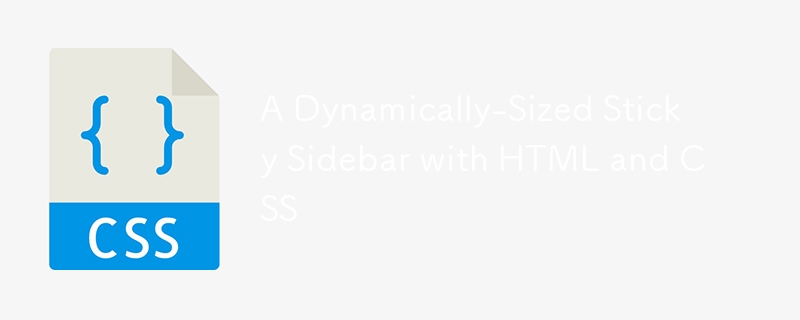A Dynamically-Sized Sticky Sidebar with HTML and CSS

Creating a sticky sidebar that adapts to viewport size is surprisingly straightforward using HTML and CSS. Leveraging position: sticky and setting a directional offset (like top: 0) allows for easy implementation of features such as jump-to-anchor menus or section headings. For more advanced sticky positioning techniques, explore resources like CSS-Tricks.
However, challenges arise when dealing with dynamically sized content within the sticky element. This can lead to content being hidden below the viewport, a common issue when the sidebar's height exceeds the available screen space.
I recently encountered this problem while designing a desktop layout with a main content area and a sidebar containing action items and filters. The sidebar needed to remain fixed to the viewport while scrolling. While initial styling was simple, the variable height of the sidebar's content presented a challenge. Using max-height and overflow-y: auto worked well on larger screens, but smaller viewports caused the sidebar to overflow.
Solving the Dynamic Height Problem
My initial approach considered using media queries to remove sticky positioning on smaller screens, making the sidebar relative to its container. However, the dynamic height of the sidebar made finding a suitable breakpoint for the media query impossible. A JavaScript solution to dynamically adjust the height based on viewport size seemed overly complex and prone to issues with window resizing.
A more elegant CSS-based solution proved effective.
Implementing the Solution
The main element utilized flexbox for layout, assigning a fixed flex-basis to the sidebar for desktop widths and allowing the article element to fill the remaining space. The Flexbox Holy Albatross technique ensured proper stacking on smaller viewports without media queries. align-self: start on the sidebar prevented its height from stretching with the main article.
The key CSS for the sticky sidebar:
1 2 3 4 5 6 |
|
This establishes the sticky behavior with a top offset controlled by a CSS custom property (--offset). This variable is reused for consistent spacing.
The sidebar component's structure:
1 2 3 4 5 6 7 8 9 |
|
This uses CSS Grid for a flexible layout. The max-height on the content section prevents excessive growth, and overflow-y: auto enables scrolling when necessary. Crucially, within the sidebar context:
1 2 3 |
|
This dynamically calculates the max-height based on the viewport height and the offset, preventing overflow.
This approach creates a responsive sticky sidebar that adapts to different viewport sizes. While suitable for desktop, further enhancements might be needed for smaller devices, such as a "jump to sidebar" button or a toggle to hide/show the sidebar. User testing will guide further iterations.
The above is the detailed content of A Dynamically-Sized Sticky Sidebar with HTML and CSS. For more information, please follow other related articles on the PHP Chinese website!

Hot AI Tools

Undresser.AI Undress
AI-powered app for creating realistic nude photos

AI Clothes Remover
Online AI tool for removing clothes from photos.

Undress AI Tool
Undress images for free

Clothoff.io
AI clothes remover

Video Face Swap
Swap faces in any video effortlessly with our completely free AI face swap tool!

Hot Article

Hot Tools

Notepad++7.3.1
Easy-to-use and free code editor

SublimeText3 Chinese version
Chinese version, very easy to use

Zend Studio 13.0.1
Powerful PHP integrated development environment

Dreamweaver CS6
Visual web development tools

SublimeText3 Mac version
God-level code editing software (SublimeText3)

Hot Topics
 1663
1663
 14
14
 1419
1419
 52
52
 1313
1313
 25
25
 1264
1264
 29
29
 1237
1237
 24
24
 Google Fonts Variable Fonts
Apr 09, 2025 am 10:42 AM
Google Fonts Variable Fonts
Apr 09, 2025 am 10:42 AM
I see Google Fonts rolled out a new design (Tweet). Compared to the last big redesign, this feels much more iterative. I can barely tell the difference
 How to Create an Animated Countdown Timer With HTML, CSS and JavaScript
Apr 11, 2025 am 11:29 AM
How to Create an Animated Countdown Timer With HTML, CSS and JavaScript
Apr 11, 2025 am 11:29 AM
Have you ever needed a countdown timer on a project? For something like that, it might be natural to reach for a plugin, but it’s actually a lot more
 HTML Data Attributes Guide
Apr 11, 2025 am 11:50 AM
HTML Data Attributes Guide
Apr 11, 2025 am 11:50 AM
Everything you ever wanted to know about data attributes in HTML, CSS, and JavaScript.
 A Proof of Concept for Making Sass Faster
Apr 16, 2025 am 10:38 AM
A Proof of Concept for Making Sass Faster
Apr 16, 2025 am 10:38 AM
At the start of a new project, Sass compilation happens in the blink of an eye. This feels great, especially when it’s paired with Browsersync, which reloads
 How We Created a Static Site That Generates Tartan Patterns in SVG
Apr 09, 2025 am 11:29 AM
How We Created a Static Site That Generates Tartan Patterns in SVG
Apr 09, 2025 am 11:29 AM
Tartan is a patterned cloth that’s typically associated with Scotland, particularly their fashionable kilts. On tartanify.com, we gathered over 5,000 tartan
 How to Build Vue Components in a WordPress Theme
Apr 11, 2025 am 11:03 AM
How to Build Vue Components in a WordPress Theme
Apr 11, 2025 am 11:03 AM
The inline-template directive allows us to build rich Vue components as a progressive enhancement over existing WordPress markup.
 PHP is A-OK for Templating
Apr 11, 2025 am 11:04 AM
PHP is A-OK for Templating
Apr 11, 2025 am 11:04 AM
PHP templating often gets a bad rap for facilitating subpar code — but that doesn't have to be the case. Let’s look at how PHP projects can enforce a basic
 Programming Sass to Create Accessible Color Combinations
Apr 09, 2025 am 11:30 AM
Programming Sass to Create Accessible Color Combinations
Apr 09, 2025 am 11:30 AM
We are always looking to make the web more accessible. Color contrast is just math, so Sass can help cover edge cases that designers might have missed.




